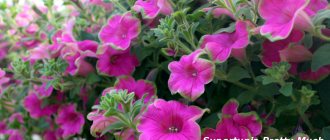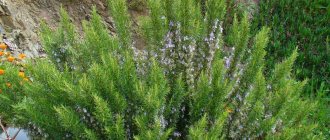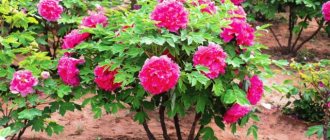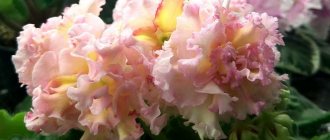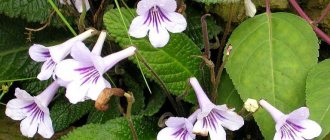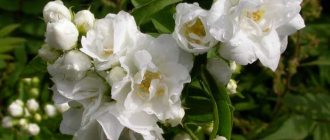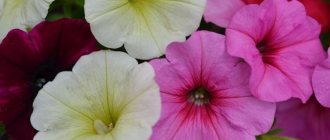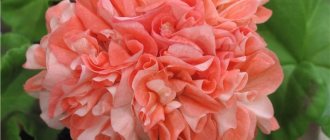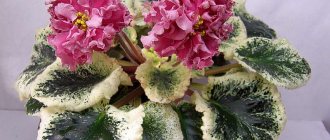The best varieties of petunia: the history of selection of the best varieties and hybrids of petunia
I started growing annual flowers in the garden and on the balcony more than 20 years ago, but I will never forget my first petunia, which I planted in the country along the path. Only a couple of decades have passed, but you’re amazed at how different the petunias of the past are from the many-sided hybrids of today! In this article, I propose to trace the history of the transformation of this popular flower from a simpleton into a real queen of annuals, and also consider the best modern varieties of petunia .
The best varieties of petunia: history of selection.
Splendor and aroma
Petunia Tumbelina Priscilla
The hybrid Atkins petunia Tumbelina Priscilla was created by English breeders and is quite resistant to the vicissitudes of the weather; the elastic flowers are not damaged by rain. All petals have contrasting veins, the central ones are strongly curled and form a lush flower of a delicate lilac color. The height of the plant is 30-35 cm, the shoots hang spectacularly from baskets and flowerpots. The magnificent flowers have a delicate aroma, which is rare among modern petunia varieties.
History of petunias: from ancestors to modern hybrids
Like many flower growers, I clearly remember that in the recent past, petunias had a characteristic “gramophone” shape of mauve tones, a strong aroma similar to the smell of fragrant tobacco, slightly sticky foliage and erect stems more than 40 centimeters high.
The most intensive selection of petunias was carried out in the West.
And Soviet flower beds and gardens were mainly decorated with petunias, outwardly close to those grown in European gardens and parks back in the 19th century. In appearance, such varieties had much in common with their wild ancestors - white petunia (Petunia axillaris) and purple petunia (Petunia violacea). How not to get confused in the varieties of petunias and choose the right one: (read more)
It is from these two natural species growing in South America that all the best varieties of petunias originate. By the way, petunia violacea was distinguished by small purple flowers, while petunia entireifolia had large white flowers.
Since petunia has not one, but several wild ancestors, the scientific name of this garden flower is “hybrid petunia”. In this regard, even if you purchase seeds of a variety and not a hybrid (F1), on the back of the bag of seeds there will in any case be the Latin inscription petunia hybrida (hybrid petunia).
Moreover, a study of the genome showed that modern petunia has most of the genes from white petunia, 10% from purple petunia, and the remaining 10% is a mosaic interweaving of genes.
It's hard to imagine, but cultivated hybrid petunia is over 200 years old. In the early 1800s, wild species of petunias were brought to Europe, where serious breeding work began on them. As a result of the efforts of breeders in Germany and Britain, specimens with larger flowers than wild species and intense flowering were obtained. However, the shape of the inflorescence and the color of the flowers still remained similar to the wild species: white, purple and, resulting from crossing, shades of lilac, pink and purple.
Interestingly, wild purple petunia attracted mainly bees as pollinators. The white one specialized in nocturnal insects, such as hawk moths and others.
By the way, a flower in the form of a gramophone ideally corresponds to the anatomical structure of butterflies, whose long proboscis can penetrate deep for nectar, and the strong smell of flowers, intensifying at night, is an additional lure for pollinators. But breeders, of course, were not focused on insects, but on improving the decorative qualities of plants. Therefore, modern hybrids have flowers with a wider throat and a relatively short tube.
Unfortunately, as a result of selection, petunia has partially lost its unique aroma, and many modern hybrids have no smell at all. I remember well how in the evenings flocks of hawkmoths circled near my first petunias, and you can rarely see butterflies and bees next to today’s petunias. However, it is thanks to hybridization that today we have a rich variety of all kinds of shades.
Until the 50s of the 20th century, all varieties of petunias were presented in only three colors: white, purple and shades of pink. Today's garden petunia has an almost complete color palette, and we have the opportunity to grow flowers in literally every shade of the rainbow. The only colors that breeders have not yet achieved are true blue and sky blue.
Note! The closer the color of the flower is to its natural appearance, the more hardy the plants are, even if they are united by the same variety series. According to Western researchers, petunias with red and yellow colors are genetically weaker.
According to my personal observations, the purple colors of various lines (Easy Wave, Explorer, etc.) are more stable and hardy, bush more strongly and bloom more profusely in comparison with other flowers of the same series.
Ampel petunia Picobella Red.
Petunia vegetative propagation
Petunia: popular varieties and close relatives
Petunia in a hanging pot Hybrid petunia first appeared in England in 1834 and became the ancestor of all the many varieties created in subsequent centuries. Of their variety, perhaps the most popular are ampelous petunias, which have long shoots from 80 to 100 cm long, hanging down or creeping along the ground. The diameter of the flower in such petunias reaches from 4 to 9 cm.
Popular varieties of ampelous petunias
Surfinia
All hanging petunias are often called this way, but in fact this is only the name of one of the variety series of hanging petunias that reproduce vegetatively. The series includes 17 varieties, forming lush cascades of flowing shoots, strewn with flowers of various colors with a diameter of 5.5 to 9 cm.
Tumbelina
A series of vegetatively propagated ampelous petunias of various colors. A distinctive feature is that the flowers are double, medium-sized, the veins on the petals are painted in a darker shade of the main color.
Supertunia
A series of vegetatively propagated ampelous petunias with large flowers with a diameter of 6-10 cm and long shoots. The root system is not as powerful as that of Fortunia, so the plants grow well in hanging pots. Flowers can be two-colored.
Conchita
A series of vegetatively propagated ampelous petunias, whose growth pattern is very reminiscent of surfinia. The flowers are small, about 5 cm in diameter, there are double varieties. Petals, pharynx and veins can be painted in different colors.
Fortunia
At the end of the last - beginning of this century, vegetatively propagated ampelous petunias were replaced by series with seed propagation. One of the first and most famous variety series is the Wave series, including Fortunia Wave F1 - one of the best ampelous petunias with shoots up to 1 m long, flower diameter 4-7 cm, lavender, blue, purple, salmon, pink, dark pink , pearl pink colors. Best grown as a ground cover. On sale there are the F1 Ramblin series, with a shoot length of about 60 cm and flowers of various colors with a diameter of 5-8 cm; F1 Rapid - shoot length 40 cm and others.
The closest relative of petunia is Calibrachoa, a species that until recently was classified as a petunia and was called Petunia parviflora (small-flowered petunia). In 1990, it was allocated to a separate genus - Calibrachoa parviflora. Externally, calibrachoa is similar to petunia, but it has thinner, highly lignified shoots with small elongated oval leaves and a huge number of small (up to 3 cm) flowers. In countries with a mild climate, calibrachoa in hanging containers forms very beautiful cascades up to 1.5-2 m long. Here it looks more modest, growing 50-80 cm over the summer. It reproduces exclusively vegetatively.
Million Bells is the most popular series of Calibrachoa varieties, a winner of many international flower exhibitions. This series includes 18 varieties with white, raspberry-pink, crimson, lilac-violet, red, cherry, brownish-yellow, lemon yellow with brown veins and pink-lilac flower colors. In addition to the varieties of this series, you can find on sale the Superbells series - 7 varieties, Cabaret - 12 varieties, Noa - 6 varieties and some others.
Groups of petunias
Petunia: varieties and cultivation
Ampelous petunia: care
Caring for petunias
How to grow petunia seedlings
supersadovnik.ru
Growing petunia Surfinia: flower care and propagation, photo
Surfinia Petunia is one of the most sought after plants on the flower market. After all, its varieties and types are very different in shape and color. Today, four groups of petunias are known: large-flowered and small-flowered, dwarf and ampelous. The latter includes petunia Surfinia.
Favorable conditions for growing petunia Surfinia
Each plant has its own preferences in conditions. Petunia Surfinia is not a very capricious flower, but is more demanding to care for than ordinary petunia. To grow it healthy and blooming, you will need some knowledge.
Favorable conditions conducive to the successful cultivation and abundant flowering of Surfinia petunia:
warm temperature conditions (the flower comes from the tropics, cold leads to the loss of inflorescences); good illumination of the plant location; regular and abundant watering in the hot season (the flower is drought-resistant, but in the summer the roots require a large amount of water); neutral or slightly acidic sandy loam soil; fertilizing with mineral fertilizers in the spring-autumn period; protection from rain and wind. Proper care
Petunia surfinia in the photo Petunia surfinia needs pruning of shoots. When the branches of a flower grow to 20-30 centimeters, they should be pinched. This approach will help shape the bush and give it the opportunity to become fluffier. Pinching is carried out only in the early stages of the growth of Surfinia petunia, since pruning delays flowering by two weeks.
Basic rules of care:
from late spring to late autumn, apply complex fertilizers; regularly remove inflorescences that have bloomed; for the winter, place Surfinia petunia in a room with an air temperature of 15-18 degrees Celsius; replant the flower if the root system is too tangled. Propagation by seeds
In nature, there are two ways to propagate Surfinia petunia:
vegetative; seminal. petunia seedlings It is very important to purchase high-quality planting material. When growing petunia surfinia, you should not plant home-collected seeds. They have poor germination, and as a result, “savage flowers” will grow. It is best to purchase F1 hybrid seeds, and even in a specialized store in professional packaging. The packs always have a photo of petunia surfinia, which makes it possible to choose the color of the flower. Also, when purchasing seeds, it is important to pay attention to the manufacturer. For example, FloraNova, Kitano, Cowel, PanAmerican and many others are very popular.
Propagation by cuttings
To propagate petunia surfinia vegetatively (by cuttings), you need to prepare in advance.
What materials should be on hand:
well-sharpened scissors or pruning shears; a special container for rooting (can be purchased at a specialty flower shop or online store); mini-greenhouse with microclimate, additional lighting and warm bottom; white peat for sowing (purchased); priming. petunia Using sharp scissors (secateurs), cut a cutting from three to seven centimeters high. It takes root in moist soil. Then the container with the cutting is placed in a mini-greenhouse for a couple of weeks. After this time, the planting material will be ready for transplanting into a pot.
The role of organic fertilizers
If the plant is regularly fed with organic matter, it will generously repay with bright and beautiful flowers. Apply fertilizers at least once every seven to ten days. For feeding, use mullein infusion or vermistim.
In the process of growing petunia Surfinia, organic fertilizers are added throughout the entire flowering period of the plant. With regular feeding, the flower will become lush and branched. As a result, a riot of color is guaranteed!
Petunia Surfinia - video review
glav-dacha.ru
Beautiful "stranger" petunia
There is hardly any annual flower that can compete with petunia in the abundance of flowering, variety of shapes, varieties and popularity. It is not for nothing that in many countries petunia ranks first in terms of sales volume. Many species and varieties make it possible to successfully use petunia for planting in borders, flower beds, hanging boxes and baskets.
Currently, first generation F1 hybrid varieties are mainly used for planting. Their advantages are compactness, abundance of flowering and resistance to diseases and external influences. A new boom in petunia breeding occurred in the 90s, when specialists from the Japanese company Suntory Ltd. In South America, forms of petunia were found that served to develop new ampelous varieties under the trademark “Surfinia” and mini-petunia “Million Bells” (calibrachoa). Unfortunately, these magnificent plants reproduce only vegetatively and are not available to hobbyists in sufficient quantities due to the high cost of imported planting material.
Similar work on the selection of ampelous petunia is carried out by other companies, in particular “Danziger” (Israel) trademarks “Cascadias”, “Petitunia”, “Calimor”, “Doublon”, Australia “Supertunia”.
At the same time, several companies are breeding hybrid trailing varieties of petunia for seed propagation. The first sign was the appearance of the Japanese petunia “Purple Wave”, which in 1995. became the winner of the American organization AAS (All America Selection) for testing and testing new varieties.
By the way, the main activity of “Kirin Brewery Co.Ltd.” – this is the production of beer (author’s note).
Petunias of this variety can be used both in ampels and as ground cover plants. The length of the shoots reaches 60-90cm, and the height is 15cm. Other manufacturers produce similar varieties of petunias: “Ramblin” (Goldsmith Seeds, USA), “AVALANCHE” (Bodger Seed, USA), “OPERA” (Takii Seeds, Japan). The main efforts of breeders focus on the resistance of varieties to weather conditions, diseases, increased bushiness, new colors and abundance of flowering. Unlike varieties of ampelous petunias of vegetative propagation, these petunias are less varied in shape, there are no double varieties and the color is usually one-color.
The seeds of these petunias have already appeared on the Russian market in NK (“Waterfall”, “Fortunia”), Suttons Seeds (“Wave”), Biotekhnika.
In 2002, new types of hybrid ampelous petunias appeared from “KIRIN BREWERY”, “TIDAL WAVE SILVER” and “EASY WAVE”. The “EASY WAVE” variety is a further improvement of the “WAVE” series, and “TIDAL WAVE SILVER” is a separate species called hedgiflora. This variety is characterized by silvery 5cm flowers with a lavender funnel, shoots up to 120cm long and up to 50cm high, which makes it especially attractive for hanging baskets. No less interesting is the use of this petunia in flower beds and rose gardens as a ground cover plant.
Of course, with good agricultural technology, you can get good results with old hanging varieties.
Petunia grandiflora
Varieties of this petunia are distinguished by large flowers 9-12cm and up to 30cm in height. Looks especially good in boxes and baskets. Flower coloring can be one-color, two-color with a border (Frost, Picotee, Hulahoop) - Sakata (“Picotee,” “Hulahoop”), Goldsmith (“Frost”), two-color with a star pattern (Star, Stellaris) - Goldsmith “Ultra Crimson Star” . There are varieties with a contrastingly colored funnel (Halo, Morn) - “Storm Pink Morn” (Goldsmith), “Horizon Coral Halo” Floranova), “Choir of Angels” (Thompson & Morgan), a mesh funnel pattern (Vein, Crystal, Ice) - varieties "Daddy" (PanAmerican Seed), "Horizon Vein Mixed" and "Prism Candy Mix" (Floranova).
The “Supercascade” variety (PanAmerican Seed Co.) was developed specifically for planting in boxes with flowers reaching 12 cm. and forming continuously blooming cascades of many flowers. The terry varieties of this group look especially impressive - “Double Cascade”, “Glorios”, “Pirouette”, “Sonata”, “Valentine” (PanAmerican Seed Co.). Flowers of various colors, shaped like carnations, will decorate any corner of the garden. Varieties and hybrids with wavy flower shapes “Razzle Dazzle” and fringed Frillytunia” (Floranova) appeared. It is impossible not to mention the varieties “Storm” (Goldsmith), “Mini Bella Picotee Mixed” (Thompson & Morgan), which have very high resistance to weather conditions and quickly restore the shape of flowers after exposure to precipitation.
Petunia multiflora (multiflora, floribunda)
Unlike the large-flowered petunia, the flowers are about 7 cm. Its main use is in mass plantings and as a border plant. This form of petunia is most often found on sale. There are many types and forms of this petunia. The most famous and popular varieties are “Celebrity” (Bodger Seeds, Ltd.), “Primetime” (Goldsmith Seed Co.), “Pearls” (Floranova), “Merlin” (Sakata), “DUO” (PanAmerican Seed Co.) . Relatively recently, a new and improved form of this floribunda petunia has appeared as a result of hybridization between large-flowered and multi-flowered - the variety “Mirage Reflections Mix” (Suttons Seed), which is more resistant to disease.
The characteristics of this petunia - flower size and height - are midway between grandiflora and multiflora.
Petunia small-flowered (milliflora)
A relatively recently appeared compact form (milliflora) of petunia with small flowers 2.5-3 cm. and up to 25 cm high - variety “Fantasy” (Goldsmith Seed Co.) Good for use in borders and as a “ground cover” plant. Compared to multiflora, this species has 15% more flowers per bush. This cute and pretty plant cannot leave anyone indifferent.
Grandiflora superbissima (f. Grandiflora superbissima)
It is necessary to mention these varieties of petunias, although they are quite rare on sale. The shoots are powerful, up to 50 cm, with large wavy flowers and a contrasting colored funnel, but unlike modern hybrid varieties they do not produce such abundant flowering. Mostly the growth goes into the tops and the decorativeness suffers from this. The most famous old variety is “California Giants” (California Giants - “Cosmea”).
Little tricks
Recently, planting flowering plants in all kinds of hanging baskets and flower pots has become popular. Looking through import catalogs, I noticed that plants planted in all sorts of vertical plastic forms and structures look very impressive. By chance, in the IKEA store, in connection with this fact, I noticed plastic hanging containers for plastic bags. This was exactly what I was looking for. To plant plants in such a container, insert a black plastic bag or film with drainage holes inside. Sprinkle soil with gel and long-acting fertilizer on top and the container is ready. We cut holes in the polyethylene in the existing holes and plant the plants as soil is added. The most suitable crops for this purpose were petunias, balsams, climbing lobelia, verbena, alyssum, and nirembergia. The photo shows the result of this idea.
Based on the experience of growing petunia “TIDAL WAVE SILVER”, after it braided a rose, the idea arose to use this property on vertical “obelisk” type supports.
Plants planted in various wooden boxes, old tubs, wicker baskets, stumps with a hollow, and wheelbarrows look more interesting.
Planting petunia
When buying seeds, you need to pay attention to a reliable seller. Very often, domestic companies sell seeds with loss of grade. This is clearly visible in the photo of petunia “Zvezda” (Russian seeds) and “Pikoti” (Aelita) - 2, where the characteristic pattern is broken. In the seedlings of the previous year and the other batch of “Pikoti” (Aelita) – 1st grade was observed. Often, instead of the stated red or blue color, pink petunia grows, which leads to wasted costs.
Imported seed packages usually indicate the batch number, germination percentage and variety purity percentage. Recently, Russian companies have begun to sell imported varieties and it has become possible to use a specific color rather than a mixture when planting. Unfortunately, they are often sold in small packaging and at an inflated price. The way out of this situation can be early planting followed by cuttings from bushes to obtain the required amount of planting material. This year’s assortment finally includes a sufficient number of imported varieties of petunias “Daddy”, “Ultra”, “Fantasy”, “Horizon”, “Limbo”, “Wave”, “Prism”, “Frillytunia”, “Frost”, “ DUO”, “Pirouette”. The main suppliers are Russian Seeds, Aelita, Biotekhnika, Poisk+, NK.
What is needed for growing seedlings: 1 - seeds 2 - boxes, cassettes for seedlings and picking 3 - pieces of glass
domir.ru
Vegetative propagation of petunia, surfinia and calibrachoa
When propagating petunias, cuttings are often used. This method is used to propagate all calibrachoa cultivar groups (Million Bells, Superbells), as well as ampelous petunias (groups Surfinia, Futura, Colgado, Cascadias, Supertunia, Conchita, etc.). Terry varieties of petunias were previously propagated in this way, since when propagated by seed they produced a low percentage of terry plants.
Terry petunias are cut from February to May; ampelous petunias and calibrachoas can be cut all year round under favorable conditions (temperature 21-24 °C and supplementary lighting with lamps in winter).
The apical cuttings with 4-6 leaves are cut from the mother plants, the top two leaves are left, shortened by half, and planted in the soil at 1/4 of the length. The cuttings should be placed in the box quite tightly, at a distance of 1.5-2 cm from each other (or 500 pcs./m2). Then the boxes are covered with glass and placed in a bright place at a temperature of 21-24 °C.
The soil for cuttings can be used the same as for sowing petunia, but a layer of sand or perlite (2-2.5 cm) must be poured on top, spilled with a fungicide solution. The soil cannot be reused for cuttings.
When cuttings, you can use growth regulators that stimulate rooting (Heteroauxin, etc.), but if the conditions necessary for rooting are met, the cuttings will root well even without these substances. The main secret to success when cutting is to place the cuttings in the soil as quickly as possible, since 1-2 hours after cutting their ability to root drops sharply, even if they are stored in humid conditions.
During rooting, the cuttings are sprayed with water from a sprayer 1-2 times a day, making sure that the soil is moist but not damp. When the first signs of mold or “black leg” appear, watering is reduced, the boxes are ventilated, and diseased cuttings are removed. After 5-10 days, roots appear on petunia cuttings. Calibrachoa cuttings root more slowly - within 2 weeks or more.
As soon as the length of the roots on the cuttings reaches 1 - 1.5 cm, they can be transplanted into pots with a diameter of 5 cm. To obtain bushier plants, the seedlings are pinched above the 4-5th leaf. The tips of the shoots, cut off by pinching, can also be used for cuttings. If necessary, pinching can be repeated after 2 weeks. After a month or a month and a half, the overgrown plants are transplanted into pots with a diameter of 11-13 cm.
Caring for petunia and calibrachoa seedlings obtained from cuttings is almost no different from caring for seedlings obtained from seeds. The only difference is that ampelous petunias and calibrachoa require much more space for normal development, so the pots with them are placed more freely or hung above the racks.
Preserving queen cells for cuttings
From double petunias, the most decorative plants with the largest and most dense flowers are selected for queen cells. At the end of August - beginning of September, the bushes are carefully transplanted into containers or pots with a diameter of at least 15-17 cm and placed in greenhouses. The main conditions for preserving queen cells are low temperatures (10-12 °C), low soil moisture and not too dry air. Fertilizing in the autumn-winter period should be done infrequently (about once a month) and only phosphorus and potassium fertilizers should be used.
Mother plants of ampelous petunia and calibrachoa must be prepared in advance. For these purposes, it is necessary to select only young, well-developed plants grown from cuttings taken in late spring - early summer. It is advisable to immediately plant the plants selected for mother plants in large pots or carefully transplant them into large pots from small ones or into the soil on a greenhouse shelf, without disturbing the root system. If there is a lack of light (without additional illumination), the queen cells can be kept in the same conditions as for terry petunia, feeding 1-2 times a month with potassium fertilizers on the leaves. Cuttings can only be taken from such plants from the end of February. If it is possible to provide mother plants with lighting and a temperature of 15-22 ° C, they can be taken from cuttings at any time as they grow. Such plants need to be fed much more often - once every 7-10 days, alternating potash fertilizers with complex ones.
The best red petunias: varieties and hybrids
For those who have only recently become interested in floriculture, red petunias are a completely common occurrence. However, it took breeders more than a hundred years to achieve a true red color. The first pure red petunia was launched for sale by the famous American company Pan American Seed only in 1953. This petunia was called “Comanche” and belonged to the multiflora (multi-flowered) series.
But since Western innovations came to us very late, I well remember the time when it was incredibly difficult to buy real red petunia, since they were passed off as crimson and purple colors, sold under fictitious names with the word “red”.
But as soon as professional seeds became available in our country, the opportunity arose to purchase real red colors of Western selection. Today, red color can be found in almost any line of hybrids. It is usually denoted by the word Red. A slightly different shade of red may also be designated Coral or Scarlet.
Typically, red petunias are plain or have a contrasting white neck at the back of the flower. Among bush petunias, red-flowered specimens are found in such popular series as:
- Mambo;
- SUCCESS!® 360°;
- Duvet;
- Bravo;
- Eagle;
- Falcon and others.
These lines form low spherical bushes, 20-25 centimeters high, covered with large flowers 10-12 centimeters in diameter.
For flower beds
Not only bush petunias are suitable for placement in flowerbeds and flower gardens. The cascading form of the plant looks impressive, when long shoots evenly cover the ground, forming a multi-colored carpet.
A popular variety of petunia for decorating a flower bed is multi-flowered. The shoots of the plant can grow up to 35-50 cm, forming a lush spherical bush. There are so many buds opening on the plant that sometimes the foliage is not visible.
Varieties and hybrids:
Ferrari - bush height up to 20 cm, width up to 50 cm, flowers 6-8 cm in diameter, scarlet, do not lose their decorative effect from rain and wind.
Califfo (hybrid) - velvet flowers up to 6 cm in diameter, colors: blue, red, burgundy, cherry, all flowers with a white border around the edge.
Elegy - the dimensions of the bush are 25 by 60 cm, the branches are simple, 7 cm in diameter, painted in a light purple hue, with a lightened neck.
Califfo
Elegy
Star (mixture of shades) - petunia, up to 30 cm high, flowers up to 8 cm in diameter, bud color - a contrasting combination of white with red, pink, purple.
Jolly is a bush petunia with lush blooms of white, blue, scarlet, and pink flowers.
Sophistry Blackberry - bush height 40 cm, flowering abundantly, until frost, the color of medium-sized flowers is burgundy-black, the structure of the petals is velvety.
Jolly
Blackbury Sophistry
Star
Ampelous red petunias
Ampelous petunias also keep up with bush petunias, and among them you can find many red ones. The most amazing deep shade of rich red has a new product of recent years - Easy Wave Red Velor petunia. In addition to its color, it is distinguished by the amazing silky texture of the petals, which literally glow in the sun. At the same time, I still want to note that despite the fact that this petunia is part of the hanging series, its bush shape is closer to cascade.
Tidal Wave Red Velor is a red version of one of the most popular ampel hybrids with silver flowers “Silver” (Tidal Wave Silver), which is loved by gardeners for the most powerful long-climbing bushes. The Tidal Wave Red Velor hybrid has the same powerful vines and abundant flowering. And the flowers themselves are similar to the hybrid Easy Wave, Red Velor described above, with a very unusual deep dark red color and silkiness. This petunia requires a large amount of soil to show itself in all its glory.
Red shades are included in many other ampelous and semi-ampel varieties of petunias:
- Explorer Scarlet;
- Opera Red;
- Picobella Red;
- Ramblin Red;
- Shock Wave Red and others.
Some hybrids combine bright red colors with white in one flower. For example, in the form of alternating red and white rays (Tango Red Star, Falcon Red and White) or a white rim on a red background (Merlin Red Picotee, Frost, Hulahup).
Terry petunia Duo red.
Classification of petunias by growth type
This is another classification based on the type of growth of petunias. Some of them grow vertically and form bushes, while others have branches that tend to grow horizontally and form spreading ground cover cushions or hanging ampels.
Bush petunias
This type of petunia includes plants that form vertically growing bushes. They can be low and compact (20-30 cm high) or taller and spreading (50-60 cm high).
Popular variety series:
- Aladdin (Aladdin) – a series of bush grandifloras, originator Benary (Germany). The plant is compact, forms a neat bush, 25-30 cm high. The flower is beautiful and large, with a corrugated edge, reaching 8-10 cm in diameter. The colors are always bright, one-color or two-color.
- Dreams (Dreams) - varieties of bush grandifloras from Pan American (USA). The shape of the bush is compact and dense, height 25-30 cm, width up to 30 cm. Flowers are at least 10 cm in diameter. Available in a wide variety of colors, including bicolor.
- Merlin (Merlin) is a series of bush multifloras, manufactured by Sakata (Japan). The plant is compact in size - up to 25 cm in height. Rain-resistant flowers, 6-7 cm in diameter, open continuously throughout the season. Wide choice of colors: plain, with a white border (Pecotee), white center (Morn).
- Limbo (Limbo) - a series of bush grandifloras, originator Hem Genetics (Netherlands). A dwarf plant, up to 20-25 cm high, does not require pinching, and branches genetically. The flowers are large, up to 12 cm in diameter. Very rich, velvety shades - single or two-tone.
- And many other varieties: Daddy (Daddy), Storm (Storm), Carpet (Carpet), Sonja (Sonya), Picobella (Picobella), etc.
Varieties of bush petunia
Ampelous petunias
A group of fast-growing petunias, growing shoots 0.5-1 m in length. Shoots tend to have a horizontal, creeping type of growth. Plants are intended to be grown in hanging baskets, containers, pots (as ampels) or in open ground (as ground covers).
Sometimes a separate category is distinguished from this group - the so-called cascading petunias. These include plants whose shoots initially grow vertically, and then descend under their own weight and become horizontal.
Well-known ampel and cascade series:
- Easy Wave (Easy Wave) is an ampelous multiflora of American selection (Pan American). A fast-growing plant, it forms long flexible stems with flowers along its entire length. The diameter of the flowers is 6-7 cm. A wide range of colors, including with a white star (Easy Wave Burgundy Star).
- Ramblin (Ramblin) - a series of cascading petunias, originator Syngenta (Netherlands). The flower is large - 7-8 cm. The plant forms dense flowering cushions, spreading over approximately 1 m2.
- Surfinia ( Surfinia ) is a series of vegetative hanging petunias from the Japanese company Suntory. Forms stuffed flower balls, with long strands hanging over the edge of the flowerpot. In the ground it spreads over 0.6-0.9 m2, some varieties can cover 1.2 m2. Flower sizes (depending on the variety) are from 3 to 8 cm. Surfinias are available in a wide range of colors: plain, with a white star, bicolor, with contrasting veins, with a white border.
- Diamond (Diamond) - ampelous hybrids, produced by Cerny Seed Company (Czech Republic). A profusely flowering plant that forms long hanging shoots 80-100 cm long. The flower is 7.5-8.5 cm in diameter. Our seed suppliers often refer to Diamond Series hybrids as “surfinia” or “surfinia type.”
- Opera (Opera) – ampelous series of hybrids, originator Takii Seeds (Japan). It grows long lashes of 1-1.5 m each. When planted in the ground, it forms a continuous flower carpet with an area of up to 1.2 m2. The flower is small, about 5-6 cm, of different shades.
- Other varieties: Explorer, Avalanche, Velvet, Shock Wave, Tidal Wave, Avalanche, etc.
You can appreciate the beauty of ampel varieties of petunias from the photo with the names of the varieties:
Varieties of ampelous petunias
The best varieties of red petunias in design
Red petunias are very often used in urban landscaping, because their bright, defiant appearance immediately attracts the eye. But in gardens, red shades are best used sparingly. This color has a stimulating effect on the nervous system and can become boring over the summer if you contemplate it every day on the site.
Red petunias would be appropriate, first of all, in the front area. At the same time, adding bright yellow flowers to them will only enhance their expressive effect. To slightly cool down the ardor of fiery red, it is better to add plants with silver foliage (cineraria, dichondra, plectranthus, etc.) or plants with small white flowers (bacopa, alyssum, gypsophila, etc.) to such petunias.
Petunias with white or beige ivory flowers also look good next to red ones. It is better not to add annuals with blue and purple colors to the company of red petunias, since such combinations give the impression of being heavy and gloomy.
Terry petunia Valentine.
Varieties
The Limbo series of petunias, in turn, is further divided into a number of subspecies:
- "Plume";
- "GP";
- "Red";
- "Burgundy";
- "Blue";
- "GP Mix";
- "GP Vained";
- "Salmon";
- "GP Violet";
- "GP Mid Blue";
- "GP Rose Picotee";
- "GP Red Wayned."
For consideration – the most common of the above.
"Limbo GP"
Description
An annual plant with quite large flowers: 9–12 cm in diameter. The petunia itself reaches 17–20 cm in height. When planted, it grows into a large bush throughout the planting area, while maintaining short stature. Blooms for a long time. It grows evenly, without stretching, maintaining a compact appearance. Used for decoration:
- flower beds;
- balconies;
- pots;
- containers.
The shades of this flower can be the following: white, coral, soft pink, yellow.
Growing
You should start growing seeds in February. Fertilizer must be selected that is suitable for this species, and do not rush with watering. Does not require the use of growth regulators. It loves light, so you should choose places that are well lit by sunlight.
"Limbo Red"
Description
Compact bush: 9–14 cm if grown in a container, 15–22 cm in open areas. Forms a branching tuber with large flowers.
Growing
Plant granulated seeds in February - April. Seedlings require light, but not direct sunlight. Dive at the 3 leaf stage. After the picking period, feed with fertilizers that contain iron.
In priority:
- light fertile land;
- sunny but protected from the wind area;
- watering, fertilizing - every 8–10 days;
- water inactively (they cannot tolerate high humidity).
"Limbo Burgundy"
Description
A decorative flower of a bright pink hue, often found on loggias, in pots, and in home areas. Used in landscaping and creating compositions. Height is 17–21 cm. Tolerates: wind, moisture, drought, cool weather. But under no circumstances should you allow stagnation of water: they do not tolerate it well. Compact: flower diameter is 7–9 cm.
Growing
Planting of seedlings is carried out in April - May, while the temperature should be from 15 degrees, and the place chosen should be illuminated. Any land, but fertile, preferably sandy loam soil. It is recommended to fertilize a week after planting and before flowering ends. Loves organic fertilizers and potassium.
"Limbo Blue"
Description
Flowering occurs earlier than other types of petunias. Seedlings - February - April, seeds - granulated. They are pleasing from the beginning of summer until the frosts. Height – 18–20 cm, diameter – 10–11 cm. Flowers have a blue tint.
Growing
Shoots begin to appear in good light, but without direct sunlight, after 10–14 days. The seeds should not be allowed to dry out, so you need to spray the soil regularly. Like other species, it is recommended to fertilize. Water moderately, plant in a sunny and wind-protected place.
"Limbo Plume"
Description
A low-growing plant that grows to the sides. Height – 16–21 cm, flowers of rich pink or dark pink tone, with a diameter of 7–10 cm. It will look good in flower beds, at the main entrance in outdoor flowerpots. Seedlings - end of February - March.
Growing
When planting, press the seeds slightly into the ground without falling asleep on top. Send to a bright place. Plant seedlings in open ground immediately after spring frosts. The flower is quite light-loving and grows well in any fertile soil.
Description
An annual plant 14–18 cm high with flowers 7–11 cm in size. This species will not replace the existing “GP”, but diversifies it perfectly. The only difference between them is that Blue Vined remains low-growing, allowing the bush to grow on the sides over a larger area. Does not require the use of growth regulators. Will decorate any container or flower bed with magnificent gray-blue or light purple flowers with a blue tint.
Growing
Planting seedlings - February - March, in a sunny place, but without direct rays of the sun. The soil can be any, but it must be fertile.
For information on how to grow petunia at home, see below.
The best yellow petunias: varieties and hybrids
More than 20 years after the red one, breeders obtained the first yellow petunia. In 1977, a new hybrid with yellow flowers was launched into cereal sales by the American company Goldsmith Seeds and was called Summer Sun.
But breeding work to improve the new shade continued, and in 1998 a new yellow-flowered petunia, Prism Sunshine, appeared, which received prestigious awards in the field of breeding Fleuroselect and American Award as “the brightest, most lush and profusely flowering.”
This cultivar was hailed as a breakthrough, as earlier varieties of yellow petunias had sparse clumps with modest blooms of pale yellow flowers. But today there is also a brighter yellow hybrid petunia, Lavina Yellow Star, with a cascading bush shape.
However, the same rich yellow tone as, say, marigolds and sunflowers, cannot yet be found in petunias. Typically, yellow petunias do not grow as bright as they appear in advertising pictures.
Among the ampelous petunias there are also specimens that bloom with yellow flowers. The previously popular Baby Duck Yellow petunia disappeared from sale for unknown reasons, but in the Easy Wave ampel series a very similar Easy Wave Yellow appeared with numerous small pale yellow flowers and a flowing bush shape.
The original yellow-green color distinguishes the bush hybrids with large flowers Debonair Lime Green and Sophistica Lime Green. The latter cultivar also has an incredibly interesting variation, Sophistica Lime Bicolor, which produces huge flowers in which yellow-green is intricately combined with crimson.
I would also like to draw the attention of flower growers to another hybrid with the presence of a yellow color “Kupala Ingrid”, the seeds of which for some reason are much cheaper than many other hybrids. And the color of the flower is very unusual. In the center of the beige inflorescences there is a mesh pattern that changes color, which can be yellow, brown and even pinkish, but from a distance such flowers look almost yellow.
Yellow petunia Sophistica Lime Green.
Planting material
For those who want to grow this plant on their property or in their yard, there are several options. You can purchase a flowering bush or grow it yourself.
Buying potted plants
The fastest and easiest way is to purchase a pot of mini petunia at a garden center or flower shop. You can purchase an already flowering specimen, but it will cost more, or you can choose a plant on which buds are just forming. Before you buy a plant, you should ask whether it has been hardened off for growing outdoors. If the manufacturer has not performed such hardening, then you will need to do it yourself, gradually accustoming the flower to outdoor conditions.
Seeds
This method is suitable for those who want to get many mini-petunias at the same time without spending a lot of money. You can sow it for seedlings, or you can sow the seeds directly on the beds or in containers where the plant will grow. Compared to its closest relative - surfinia - mini-petunia is much more viable and grows more amicably in open ground.
Sowing seedlings
Sowing of seedlings is carried out in February-March.
Earlier sowing will lead to the fact that the sprouts will not have enough short daylight hours, so the seedlings will stretch out and be weak. The pace of their growth and development will slow down, and perhaps a complete cessation of dynamics. For seedlings that are sown earlier than the end of February, it is necessary to organize additional lighting so that there is at least 10 hours of daylight per day.
Seedlings need nutritious soil for flowering plants. If the soil is compiled independently, it is necessary to add a sufficient amount of organic matter to it: compost, processed manure, turf soil or leaf soil. Seeds are sown on the surface of the container, spraying them with a spray bottle.
In the case of spruce granulated seeds, spraying should be even more abundant, because the shell of fertilizers and nutrients must soften so that a sprout can easily break through. After this, the container is covered with transparent glass or film to create a greenhouse effect inside.
The container must be installed in a warm place with good lighting.
For regular seeds, germination time is 5-10 days, and for granulated seeds – 10-20.
Growing
As soon as the first seedlings appear, careful care of the seedlings is necessary so that they do not die:
- spraying twice a day;
- moving to a place with a temperature of 18-20°C, since higher temperatures can destroy the sprouts;
- airing once a day for 10-15 minutes;
- After the first two leaves appear, you need to apply fertilizer with a weak solution for deciduous plants so that the green mass actively develops.
When the seedlings grow three full leaves, they need to be plucked. This measure is necessary for the normal formation of the root system. After the sprouts reach a height of 10-12 cm, they need to be pinched at the tops. If you do not pinch them, the bush will not be spherical, and after this the active formation of side shoots begins.
Disembarkation
Young mini petunias should be planted when the threat of frost has passed outside. In the southern regions, this can happen as early as mid- or late-April, and in colder regions, nighttime cold spells can persist until early June.
Sowing in open ground
Seeds should be sown in open ground no earlier than mid-May. Mini petunias grown in this way are characterized by greater resistance to diseases and weather conditions.
The principle of sowing is the same as for seedlings, but there is no need to cover the beds with film. Mini petunias, which were grown immediately in open ground, show a rapid pace of development and by the beginning of flowering, as a rule, they catch up with specimens grown by seedlings.
Varieties of yellow petunias in design
Yellow petunias look very cheerful and create a sunny mood in any corner. This shade is one of the easiest to create all kinds of combinations. Yellow hybrids will look best in the company of plants with purple and blue flowers, be it purple petunias or any other annuals (lobelia, alyssum, ageratum, brachycoma, etc.).
Plants with red flowers (for example, hybrid verbena or pelargonium) in the company of yellow petunia will create a feeling of solemnity and will never be left without attention. Pink tones combined with yellow flowers are the key to creating a gentle romantic atmosphere.
The large flowers of yellow petunias are perfectly combined with ampelous pink diascia, clouds of pink alyssum Easter Bonnet Peach and other pink and lilac annuals.
Easy Wave Yellow petunia and snapdragon.
Briefly about the plant and its history
ATTENTION : South America remains the homeland of low-growing petunia. The plant is classified as a herbaceous perennial, but in Russia it is grown as an annual. Petunia is not suitable for growing indoors. It decorates windows and balconies only from the outside.
The genus name comes from the word petun, meaning tobacco . And this is no coincidence, since the leaves of the plant resemble tobacco. They are of a solid type, located on short petioles. Their size and shape vary. The arrangement on the stems is alternate. The stems themselves are green and branched. Depending on the variety, petunias can be hanging or erect.
The flowers of low-growing petunia are shaped like a funnel. They can be large and small-colored, terry and simple. Their colors are quite wide:
- white;
- red;
- blue;
- lilac;
- violet.
You can often see petals that combine two shades at once and have a variegated pattern. The edges of petunia petals are smooth and fringed .
The best black petunias: varieties and hybrids
The first black petunia was obtained by breeders much later than most other colors - only in 2011. Such petunia could be found on sale under two trade names Black Velvet (“Black Cat” and “Black Velvet”).
The latter name well reflects the velvety surface of the petals, which in reality are not completely black, but have the darkest violet-purple color. In the right lighting it can actually appear black.
Despite the fact that this petunia looks fantastic, the creators claim that this color was obtained using traditional selection, without the use of genetic engineering. Because black color is unique to petunias, this new product was described as "a revolutionary breakthrough."
Along with the monochromatic black petunia, the vegetative hybrid “Phantom” was also launched for sale, the color of which, along with black, included bright yellow stripes. This mystical petunia won a gold medal at the international Fleuroselect Industry Award competition, impressing the jury with its unique contrasting color.
Later, other hybrids appeared with almost black color Debonair Black Cherry - black with a burgundy tint and Sophistica Blackberry - with a slightly lighter color than the Black Velvet petunia; both hybrids are distinguished by large velvety flowers and a spherical bush shape.
Black petunia Phantom.
Black petunias in garden design
Most gardeners buy black petunias for the first time out of curiosity, and only after purchasing they wonder where to place the unusual plant in the garden. At the first presentation of the Black Velvet hybrid, the flower was presented under the motto “Black goes with everything!” And, indeed, it is much easier to choose partners for black petunias than for some other flowers.
For example, a combination of black and white works very well, so to refresh gloomy petunias it is better to add small white flowers (verbena, alyssum, bacopa, gypsophila, euphorbia and others). This shade also goes great with yellows, pinks and oranges. However, the main questions arise when arranging compositions with such petunias in the garden.
When choosing a suitable location, it is worth considering that from a distance the dark color is practically not “readable” and black petunia flowers are best viewed up close. An important point is that the color intensity of Black Velvet petunias changes during the day, and at dusk such flowers simply “disappear.” The main area of application for black petunias is the use of these flowers in the garden as an original accent.
Possible problems
In the process of growing low-growing petunia, some problems may arise:
- Lack of flowering and sloppy appearance of the plant . This occurs when the soil is heavily waterlogged or when there is prolonged rain. If possible, it is better to move the flowerpots with flowers to a shelter and normalize watering.
- Lack of abundant flowering . This problem can occur due to poor-quality feeding, as well as when faded buds are not removed. They will not add decorative value to the bush, but the plant itself will spend a lot of energy on forming fruits rather than new inflorescences.
- It is necessary to shape the plant for its lush, beautiful and neat appearance. For these purposes, pinch the shoots above 3 leaves. This will be an excellent stimulation for the formation of flower buds.
The best blue and cyan petunias: varieties and hybrids
Blue or blue petunias are worth mentioning separately. True blue petunias of cornflower blue color or blue, like forget-me-nots, do not currently exist. Therefore, you should not trust the designations of the hybrid as “Blue” and “Sky Blue”.
Typically, petunias called blue petunias produce purple petunias, and blue petunias produce violet-purple petunias. Some hybrids may have both purple and lilac flowers on one bush, since as they bloom they change color and fade in the sun.
Of the best varieties among blue petunias, you can pay attention to the hybrid Easy Wave Lavender Sky Blue. The shape of the bush of this cultivar is ampelous, the flowers are quite large with a silky texture. The inflorescences have a pleasant, mild aroma. Flowers of different shades of purple and lavender are simultaneously observed on the bush. Moreover, during cool weather and in lower lighting, the color of the flowers becomes darker.
Other ampelous petunias that are classified as blue:
- Opera Supreme Light Blue;
- Ramblin Sky Blue.
Among the best varieties of lump petunias, I would especially like to highlight the Merlin Blue Morn hybrid. This is a multi-flowered compact petunia, reaching a height of 25 cm with a large number of medium-sized inflorescences. The color of the flowers gradually lightens from dark purple around the edges to almost blue in the center.
Other bush petunias in “blue” (lavender) colors:
- Limbo GP Sky Blue;
- Ultra sky blue;
- Dreams Sky Blue;
- Aladdin sky blue.
Petunia Easy Wave Lavender Sky Blue.
Features of terry petunia
The birthplace of petunias is Brazil. Their name comes from the Portuguese word petun - “tobacco” and this is not surprising, because both plants belong to the nightshade family.
The length of shoots in double varieties usually does not exceed 30-45 cm. Their main feature is the presence of several rows of flower petals. They may differ from each other in several ways. Let's look at them in the table:
| Category | Types of flowers | Description |
| Flower size | Large | 10 cm or more |
| Average | 5-9 cm | |
| Petal shape | Wavy | With a relatively smooth edge |
| Fringed | The edge is heavily cut | |
| Petal color | Plain | The petals are the same color, but its saturation sometimes changes from the center to the edges |
| Two-color | The color contains two contrasting colors, and their border on the petals can be clear or blurred | |
| Number of petals | Semi-double | There are 1-2 rows of additional petals inside, all of them are clearly visible |
| Terry | More than 3 rows of petals, with the core of the flower visible | |
| Full-double | Densely packed flower with many petals, the core is not visible |
Blue petunias in garden design
Petunias in shades of purple work best with plants that have yellow and orange flowers or foliage. Therefore, among the beautifully flowering annuals, it would be a good idea to add low-growing snapdragon, thunbergia, nemesia, calibrachoa, etc. to the “blue” varieties.
Ornamental foliage plants with orange and yellow foliage, such as numerous hybrids of coleus and sweet potato morning glory, will also be an excellent addition. Adding white to purple petunias creates a crisp, cool combination that will be refreshing on a hot summer day. Purple petunias can become partners with both other white petunias and annuals with a scattering of small light flowers.
Common diseases and pests
With proper care, low-growing petunia will be able to resist diseases and parasite attacks . Excess or lack of water, dense planting, lack of sun, and soil acidification weakens its immunity. Among viral and bacterial diseases, the following pose a particular danger to petunia:
- cucumber and tobacco mosaic;
- leaf galls;
- potato and tomato viruses;
- tobacco necrosis.
IMPORTANT : They are characterized by necrotic and chlorotic spots, a mosaic pattern on the leaves, and also deformation of various elements of the flower. The affected plant must be removed and burned. For prevention, control aphids, as they are carriers of these diseases.
Common fungal diseases include:
- powdery mildew;
- late blight;
- black leg;
- brown spot.
To combat fungal diseases, preparations containing copper are suitable . Biological and chemical preparations such as Fitosporin and Trichodermin are also effective.
The most dangerous pests of petunia include:
- aphids;
- slugs;
- ticks;
- whitefly
To combat them, insecticides are used, including Konfidor and Aktara. To combat spider mites, special preparations are suitable: Demitan, Actellik. To repel slugs, disperse metaldehyde over the soil.
The best orange petunias: varieties and hybrids
Orange petunias have only appeared on sale in recent years. In 2014, a Japanese company introduced a hybrid called African Sunset. It turned out to be impossible to obtain an orange color in petunias using traditional breeding methods, and then one of the companies resorted to a trick by launching transgenic orange petunia, bred for scientific purposes, without GMO labeling.
But at present this variety is prohibited for sale in Europe, the USA and Australia, and from us you can only buy remnants of old supplies.
Other varieties of salmon-colored petunias that can be found for sale:
- Eagle Salmon;
- Picobella Salmon;
- Duvet Salmon;
- Ez Rider Deep Salmon;
- Ramblin Peach Glo;
- Easy Wave Coral Reef;
- Amore Mio Orange.
Orange and salmon petunias look great in container arrangements in the garden and on the balcony, combined with yellow or purple colored annuals.
